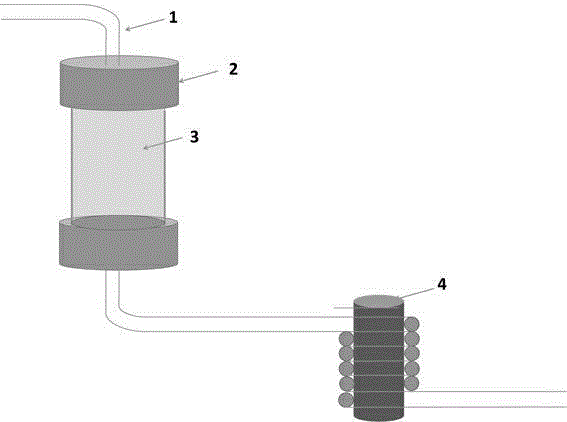Blood heavy metal ion adsorbent, preparation method thereof and blood perfusion device
A heavy metal and adsorbent technology, applied in the field of medical materials, can solve the problems of no specific selective adsorption performance, few surface active groups, and high price, so as to reduce the risk of systemic complications in the body and avoid protein denaturation loss. the effect of reducing the content of heavy metals
- Summary
- Abstract
- Description
- Claims
- Application Information
AI Technical Summary
Problems solved by technology
Method used
Image
Examples
Embodiment 1
[0040] A blood heavy metal adsorbent made of magnetic nano-material NiFe 2 O 4 As a carrier, the surface of the carrier is modified and coated with a ligand active group -COOH that can bind with lead, cadmium, mercury ions and their complexes.
[0041] The preparation method of the blood heavy metal adsorbent of this embodiment includes the following steps:
[0042] 1) Add 0.5 mol of iron acetylacetonate, 0.25 mol of nickel acetylacetonate, 1.5 mol of octadecenoic acid and 2.0 mol of octadecenamine to 100mL of octadecene and stir evenly, first heat to 150℃ for 4 hours, then cool After reaching room temperature, vacuum degassing for 30 minutes, and then continue heating to 200° C. and react for 8 hours. After the reaction is completed, cool to room temperature naturally. Then add 300 mL of absolute ethanol, centrifuge at 10,000 rpm for 10 minutes, discard the supernatant, add 10 mL of toluene and mix well, then add 30 mL of absolute ethanol, and centrifuge. After repeating the abov...
Embodiment 2
[0051] A blood heavy metal adsorbent with magnetic nano material Fe 3 O 4 As a carrier, the surface of the carrier is modified and coated with a ligand active group -COOH that can bind with lead, cadmium, mercury ions and their complexes.
[0052] The preparation method of the blood heavy metal adsorbent of this embodiment includes the following steps:
[0053] 1) Add 0.5 mol of iron acetylacetonate, 0.25 mol of ferrous acetylacetonate, 1.5 mol of octadecenoic acid and 2.0 mol of octadecenamine to 100 mL of octadecene and stir evenly, first heat to 150°C for 4 hours, then Cool to room temperature, degas in vacuum for 30 minutes, then continue to heat to 200°C, react for 4 hours, after the reaction is completed, cool to room temperature naturally. Then add 300 mL of absolute ethanol, centrifuge at 10,000 rpm for 10 minutes, discard the supernatant, add 10 mL of toluene and mix well, then add 30 mL of absolute ethanol, and centrifuge. After repeating the above centrifugation step 3-...
PUM
| Property | Measurement | Unit |
|---|---|---|
| particle diameter | aaaaa | aaaaa |
| concentration | aaaaa | aaaaa |
Abstract
Description
Claims
Application Information
 Login to View More
Login to View More - R&D
- Intellectual Property
- Life Sciences
- Materials
- Tech Scout
- Unparalleled Data Quality
- Higher Quality Content
- 60% Fewer Hallucinations
Browse by: Latest US Patents, China's latest patents, Technical Efficacy Thesaurus, Application Domain, Technology Topic, Popular Technical Reports.
© 2025 PatSnap. All rights reserved.Legal|Privacy policy|Modern Slavery Act Transparency Statement|Sitemap|About US| Contact US: help@patsnap.com

